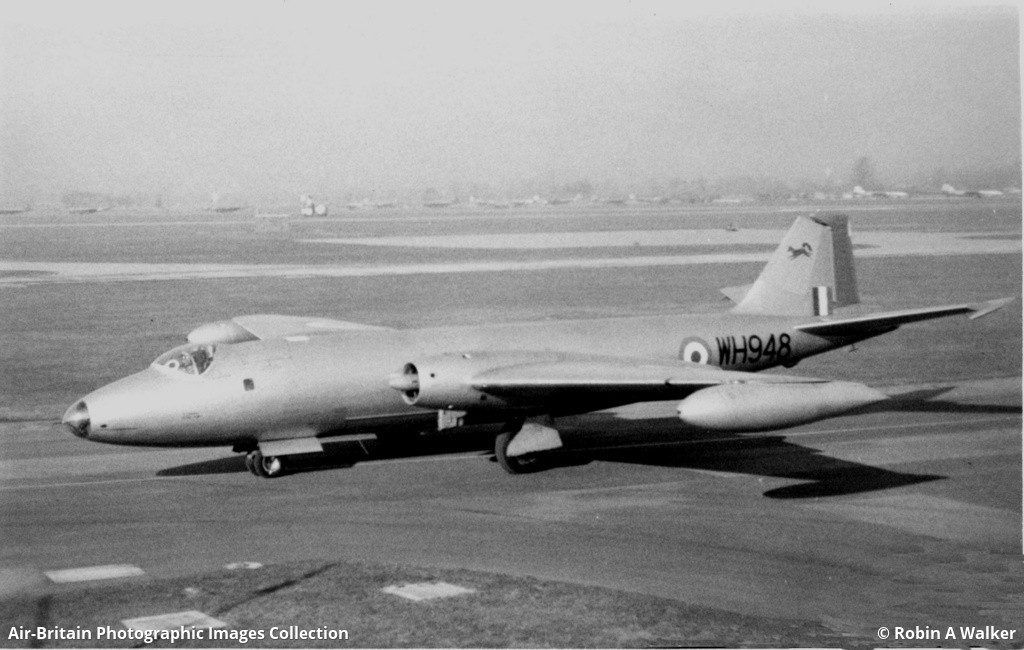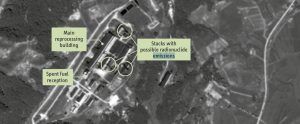Krypton 85 monitoring: Solution to clandestine reprocessing
By Michael Schoeppner | April 10, 2019
 During the Cold War, Canberra bombers such as this one were used by the Royal Air Force to collect samples from the atmosphere, to see if there were any elevated levels of the radioactive material krypton 85 to indicate that the Soviets had done any reprocessing of spent nuclear fuel to make plutonium-based nuclear bombs. Image courtesy Robin A. Walker, https://abpic.co.uk
During the Cold War, Canberra bombers such as this one were used by the Royal Air Force to collect samples from the atmosphere, to see if there were any elevated levels of the radioactive material krypton 85 to indicate that the Soviets had done any reprocessing of spent nuclear fuel to make plutonium-based nuclear bombs. Image courtesy Robin A. Walker, https://abpic.co.uk
One of the many obstacles to reaching an arms-control agreement with North Korea revolves around the risk that undeclared, clandestine nuclear facilities might exist in that country, which—if they remain undetected—would allow the Kim Jong-un regime to maintain and continue its military nuclear ambitions. It is therefore very important that any agreed-upon denuclearization of the Korean peninsula includes methods to verify that North Korea is not conducting any illicit reprocessing—the procedure where fissionable material such as plutonium is recovered from spent nuclear fuel, and used for making nuclear bombs.
Limiting or banning the production of plutonium and highly enriched uranium—also known as fissile materials—is also the concern of a possible worldwide future Fissile Material Cut-off Treaty, for which verification is still an open topic. But regardless of what denuclearization deal, safeguards agreement, or treaty umbrella that it falls under, the situation in North Korea leaves negotiators with a conundrum: How to be sure that North Korea has stopped all reprocessing at its openly declared sites, and that there are no hidden reprocessing plants operating somewhere? These questions become even more important when considering the possibility of a future North Korean civilian nuclear program.
But a solution to verifying the absence of clandestine reprocessing activities may already be at hand in the form of wide-area environmental sampling, which—if enacted—would ultimately allow for remote airborne monitoring, from a distance, of what is going on inside North Korean facilities.
Closing a verification gap. Wide-area environmental sampling has a long history; similar methods were used by the West in the early days of the Cold War to learn about Soviet plutonium production levels. It was an ideal method for the detection of reprocessing plants, which have no distinct outside structure and are easy to hide, as they can easily be mistaken for a harmless, generic industrial building.
The thinking behind the detection method goes like this: Plutonium—the key fuel in a Nagasaki-type bomb—is produced in a nuclear reactor by irradiating uranium and later separating it from the bulk uranium by chemical methods at what is known as a reprocessing plant. During irradiation, a number of fission byproducts are also created—one of which is the radioactive noble gas krypton 85, which is inevitably released when the cladding of a spent uranium fuel rod from a reactor is opened during reprocessing. Krypton 85 is difficult to control and winds up in the atmosphere, where it could be detected downwind by daily airborne sampling flights conducted over the Korean peninsula by specially equipped planes or drones.
Because there are no natural sources of krypton 85 and significant amounts are only released during reprocessing, any elevated concentrations in the atmosphere are consequently a sure sign of reprocessing activities upwind from the sampling location. Therefore, krypton 85 monitoring could in principle be used to monitor known but inaccessible reprocessing plants—and even detect entirely unknown, clandestine reprocessing plants, says new research published by the International Panel on Fissile Materials. The new study shows that this remote detection of reprocessing would be a logistical challenge, but nevertheless could be accomplished.
The monitoring of krypton 85 could be relatively easily applied to verify the shutdown of known military reprocessing plants in countries such as India, Israel, North Korea, and Pakistan—nations that are otherwise inaccessible, so far as safeguards and inspections go. Research has shown that two or three krypton 85 monitoring stations placed in the direction where the wind blows with the highest probability could verify the shutdown of a reprocessing facility. An arrangement such as this would allow the host country—in this case, North Korea—to preserve confidential information until dismantling is completed, while giving outside parties the certainty that plutonium separation in any declared facility has stopped.
A monitoring program such as this would require only a relative handful of resources to see if clandestine reprocessing is present or not in a small-ish country or region. A country the size of North Korea (120,000 square kilometers, or about 46,332 square miles) could be monitored with only two-to-three air samples per day, taken at random locations over its surface area. For a smaller country like Israel—about 20,000 square kilometers, or 7,772 square miles—reprocessing activities could be monitored with just one random sample per day. (To be sure, the number of samples required depends not only on the size of the country but also on the typical wind and dispersion patterns.)
And such a detection scheme could also be applied to much, much larger geographic areas—or even worldwide—though more resources would be required to detect a clandestine plant over that large a space.
To monitor 10 million square kilometers, for example—an area roughly the size of either the United States, or China, or the combined Middle Eastern countries that have nuclear technology—50 air samples per day would be needed, spread out over the whole geographic area, in order to reliably detect illicit reprocessing activity before enough has been produced to fuel a first-generation Nagasaki-type bomb (about 8 kilograms of weapons-grade plutonium, or a bit more than roughly 17.5 pounds, according to the International Atomic Energy Agency.) This is possible, but it would be a logistical and financial challenge.
Monitoring on this scale could be achieved through airborne sampling by planes or drones sent on daily sampling missions to random locations, delivering the air samples to a laboratory for analysis. This would be sufficient to detect reprocessing activities with a certainty of 90 percent, before 8 kilograms of plutonium could be accumulated—though it should be noted that reprocessing plants that separate plutonium especially slowly would require about three times more samples per day, because their krypton 85 footprint quickly becomes invisible against the existing background. This difficulty is independent of the sampling technique or the detection system and can only be overcome with a reduced background.
And therein lies the hitch.
Reducing the current background level can only be achieved by reducing—or, better yet, ceasing entirely—all reprocessing activities. If that was done, then it would be much more feasible for this method to verify that a country has abandoned its reprocessing effort over the long term—yet another compelling reason to put into force the Fissile Material Cut-Off Treaty, and finally limit or ban altogether the production of plutonium and highly enriched uranium. (The last major users of highly enriched uranium fuel—planned naval reactors—could be designed to use low enriched uranium.)

One more reason to make the treaty a reality. As things now stand, unfortunately, large-scale reprocessing for military and civilian purposes over the past decades has emitted huge amounts of krypton 85 into the atmosphere, limiting the usefulness of this approach. For decades, all of the nine nuclear-armed states have produced plutonium for their weapon programs—and consequently emitted krypton into the atmosphere. While the five states holding the largest nuclear arsenals (the United States, Russia, France, China, and the United Kingdom) have ended such production for weapons, the other four (Pakistan, India, Israel, North Korea) continue production. Today, plutonium also is separated for use in civilian nuclear power programs in France, Japan, Russia, India and China, despite well-established economic, safety, and security arguments against such separation for use in nuclear power fuel.
Current emissions lead to increased concentrations in the air downwind from operating reprocessing plants until the plume is dispersed; they also add to the total content of krypton 85 in the Earth’s atmosphere. Krypton 85 decays with an 11-year half-life but, for over 60 years, new releases have outweighed decay, creating an omnipresent krypton 85 background in the atmosphere. This accumulated background limits the range over which freshly emitted krypton-85 can be detected, thereby lowering today’s detectability of clandestine reprocessing plants. The higher the background concentration of krypton 85, the quicker the plume from a reprocessing plant, declared or undeclared, becomes undetectable.
Today, industrial-scale civilian reprocessing in France and in the United Kingdom (scheduled to continue until 2020), is happening on much larger scales than military reprocessing in India, Pakistan, North Korea, and Israel. As a result, most of today’s krypton 85 emissions is released from civilian plants. (And by 2021, the situation will become worse, when Japan plans to expand its reprocessing activities.)
Because of the accumulated background from historical reprocessing, freshly emitted krypton 85 plumes can typically be detected only up to a few hundred kilometers away, at best. But krypton 85 plumes could be detected from thousands of kilometers away, if civilian and military reprocessing ceased and the background krypton 85 were left to naturally decay away. (This estimate is based upon experience with radioxenon—another radioactive noble gas—which, due to a much lower presence in the background, can be used in a similar manner to detect nuclear explosions from thousands of kilometers away.)
So what does all this tell us? Abandoning reprocessing would, over time, allow for the monitoring of clandestine plants, with fewer resources, and allow the detection of even small clandestine reprocessing efforts. After 10 years of zero emissions of krypton 85, only 20 air samples would be required per day to monitor 10 million square kilometers (3,861,022 square miles, or a land mass about that of China’s), instead of 50 air samples. After 30 years, only five samples per day would be required. This would provide the international community with a feasible capability to verify the absence of clandestine plutonium-pathway nuclear weapon programs.
Because most krypton 85 is released from civilian plants in just a few countries, ending those civilian reprocessing programs would contribute greatly towards the improved detectability of clandestine reprocessing activities. This is just one more reason to stop civilian reprocessing of nuclear fuel, in addition to the many other arguments against it.
Ending civilian reprocessing (for plutonium fuels) would save the nuclear utilities billions of dollars per year and improve nuclear safety and security. More importantly, ending civilian and military reprocessing programs would pave the way to a world where even the mere attempt to secretly separate small amounts of plutonium would be detectable—be it in North Korea or elsewhere.
And from a big-picture perspective, if this effort were undertaken at the same time as a ban on the production of highly enriched uranium—a proposal based on an International Panel on Fissile Materials study whose results were analyzed in an earlier Bulletin article—then together these two bans would further reduce the dangers of nuclear proliferation and nuclear terrorism.
Verifiably ending both the separation of plutonium and the production of highly enriched uranium—in other words, monitoring every nation’s compliance with a comprehensive ban on fissile materials for all purposes—is indeed a viable international goal. It should be pursued as it would foster verification that any potential agreement is being adhered to, and thereby significantly enhance global nonproliferation and progress towards nuclear disarmament.
(This article is based on “Remote detection of undeclared reprocessing,” a research report published by the International Panel on Fissile Materials.)
Together, we make the world safer.
The Bulletin elevates expert voices above the noise. But as an independent nonprofit organization, our operations depend on the support of readers like you. Help us continue to deliver quality journalism that holds leaders accountable. Your support of our work at any level is important. In return, we promise our coverage will be understandable, influential, vigilant, solution-oriented, and fair-minded. Together we can make a difference.
Keywords: Fissile Material Cut-off Treaty, North Korea, spent fuel reprocessing
Topics: Analysis, Nuclear Risk














